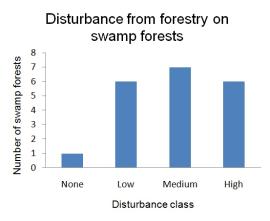Follow-up study

Out of the 20 swamp forests, one site was totally unaffected by forestry since 1999 (class 0/3), six forests showed low effects (class 1/3), seven forests showed medium effects (class 2/3), and six forests showed high effects (class 3/3) (Table 1). The most common disturbance factors were adjacent clear-cuts and forest roads. Protective zones had not been left purposely, but were more the result of certain areas being unmanageable due to rough terrain. Two forests have been incorporated in a nature reserve, created in June 2013. Generally, the amount of lichen occurrences found in 2013 was lower than in 1999 (Table 2). M. terebrata remained at 7/10 forests, T. lepadinum remained at 6/9 forests, and G. scripta remained at 16/19 forests. The proportion of remaining alders varied between forests, but was mostly lower than in 1999.

Responsible for this page:
Director of undergraduate studies Biology
Last updated:
05/28/14
